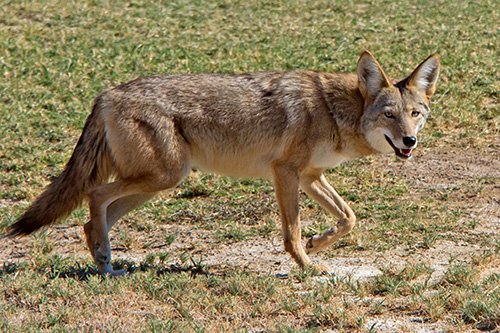If you live in Florida you’ve probably heard people talk about coyotes in Florida.

Coyotes are found in every Florida county. Their level of abundance cannot be measured merely by anecdotal sightings since coyotes try to blend in with their surroundings and not be seen. Sightings of coyotes do not necessarily mean that they are more abundant where sighted. Coyotes are wherever there is suitable habitat, regardless of whether or not they are seen. A sighting only confirms that coyotes are present.
Coyotes can be active at any time of day or night, but they are mainly nocturnal and crepuscular (active around dawn and dusk)
Don’t allow your dogs or cats to roam freely. Most coyote attacks on pets occur either at night or in the early evening and early morning hours (that is, dusk and dawn). During those times especially, be careful if you’re going to walk your pet in wooded areas or areas where there are a lot of other plants growing, which could hide coyotes. Also, keep your dog close, on a short leash. Keep cats indoors. When cats roam freely there is an increased risk that they could be attacked by coyotes.
Be cautious if you are going to pick up your pet when you see a coyote. Picking up a pet may stop a coyote attack, but it can also lead to a situation in which an aggressive coyote continues to go after that pet while in the arms of a person.
Coyotes mainly eat small mammals. Rabbits and rodents make up the bulk (90%) of their diet in most areas. Larger animals such as deer are also commonly eaten, but mostly as scavenged carcasses, although sometimes after a chase in which several coyotes worked together to take down the animal. Other food items include fishes (which they are capable of snatching from streams!), lizards, snakes, birds such as turkeys, insects, grasses, fruits (including watermelon, persimmon, and various wild berries), and seeds. A tracking study conducted in Tucson, Arizona, found that over a 33-day period during November 2005 through February 2006, a group of eight coyotes killed 19 domestic cats. This interesting study further strengthens the idea that domestic cats are much better off if kept entirely indoors. The coyote is also capable of preying on small domestic dogs.
Coyotes are very speedy runners! Picture this: a coyote racing in the World Championships in Athletics against legendary world record-holder Usain Bolt. Usain runs a breathtakingly fast time of 9.58 seconds for the 100‑meter sprint. That’s 23.4 miles per hour (mph) (37.7 km/hour)! Now, let’s focus on the coyote. The coyote explodes out of the starting line at a staggering pace, crossing the finish line in about half the time (4.47 seconds) it took Usain to cover the same distance! That’s right, coyotes are fast and capable of running at speeds of up to 50 mph (80.5 km/hour) (Sooter 1943, Fisher 1975). Although Novak (1999) gives a top speed of 64 mph (103 km/hour), this is higher than what is stated by most other sources. Coyotes are clearly one of the fastest terrestrial mammals in North America.
